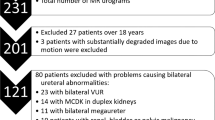Abstract
Background
We have previously shown that urinary bladder volume index (BVI = length × width × depth of bladder) and bladder volume wall thickness index (BVWI = BVI at full bladder/average bladder wall thickness) are useful indicators of bladder dysfunction in children with enuresis and urinary tract infection. These indices show a good correlation with urodynamic studies. We have expanded the study to include normal paediatric subjects with a wide age range. We illustrate a simple sonography protocol with nomograms of different parameters, which provide useful references for functional assessment in children with urological abnormalities.
Objective
To construct nomograms of total renal volume, maximum BVI and BVWI based on a Chinese paediatric population with age range from newborn to adolescence.
Materials and methods
Sonography was performed in consecutive children with normal urinary tracts on imaging, using a standardized protocol. Data were collected for construction of nomograms for different parameters.
Results
Nomograms of total renal volume, BVI and BVWI were constructed based on 3,376 consecutive paediatric subjects. All parameters consistently increased with age.
Conclusion
Nomograms of total renal volume, BVI and BVWI could provide useful references for studying bladder dysfunction in children using noninvasive dynamic sonography.






Similar content being viewed by others
References
Leung VY, Chu WC, Yeung CK et al (2006) Ureteric jet Doppler waveform and bladder wall thickness in children with nocturnal enuresis. Pediatr Res 60:582–586
Yeung CK, Sreedhar B, Leung VY et al (2004) Ultrasound bladder measurements in patients with primary nocturnal enuresis: a urodynamic and treatment outcome correlation. J Urol 171:2589–2594
Yeung CK, Sreedhar B, Leung VY et al (2006) Correlation between ultrasound bladder measurements and urodynamic findings in children with recurrent urinary tract infection. BJU Int. DOI 10.1111/j.1464-410X.2006.06580.x
Griffith CJ, Murray A, Ramsden PD (1986) Accuracy and repeatability of bladder volume measurement using ultrasonic imaging. J Urol 136:808–812
Cole CJ, Freeman JV, Preece MA (1998) British 1990 growth reference centiles for weight, height, body mass index and head circumference fitted by maximum penalized likelihood. Stat Med 17:407–429
Jequier S, Rousseau O (1987) Sonographic measurements of the normal bladder wall in children. AJR 149:563–566
Kaefer M, Barnewolt C, Retik AB et al (1997) The sonographic diagnosis of infravesical obstruction in children: evaluation of bladder wall thickness indexed to bladder filling. J Urol 157:989–991
Manieri C, Carter S, Romano G et al (1998) The diagnosis of bladder outlet obstruction in men by ultrasound measurement of bladder wall thickness. J Urol 159:761–765
Robinson D, Anders K, Cardozo L et al (2000) Can ultrasound replace ambulatory urodynamics when investigating women with irritative urinary symptoms? Br J Obstet Gynaecol 109:145
Ukimura O, Kojima M, Inui E et al (1998) Non-invasive evaluation of bladder compliance in children using ultrasound estimated bladder weight. J Urol 160:1459–1462
Wein AJ (2002) Pathophysiology and categorization of voiding dysfunction. In: Walsh PC, Retik AB, Vaughan ED et al (eds) Campbell’s urology, vol 2. Saunders, Philadelphia, pp 887–891
Zderic SA, Chacko S, Disanto ME et al (2002) Voiding function and dysfunction. In: Gillenwater JY, Grayhack JT, Howards SS et al (eds) Adult and pediatric urology, vol 2. Lippincott Williams & Wilkins, Baltimore, pp 1098–1104
Brkljačić B, KuXmić AC, Dmitrović R (2004) Ultrasound-estimated bladder weight in healthy children. Eur Radiol 14:1596–1599
Kuzmić AC, Brkljačić B, Ivanlović D (2003) The impact of bladder shape on the ultrasonographic measurement of bladder volume in children. Pediatr Radiol 33:530–534
Roberts DS, Rendell B (1989) Postmicturition residual bladder volume in healthy babies. Arch Dis Child 64:825–828
Nøgaard JP, van Gool JD, Hjalmas K et al (1998) Standardization and definitions in lower urinary tract dysfunction in children. International Children’s Continence Society. Br J Urol 81 [Suppl 3]:1–16
Müller L, Bergström T, Hellström M et al (2000) Standardized ultrasound method for assessing detrusor muscle thickness in children. J Urol 164:134–138
Watanabe H, Kawauchi A (1995) Is small bladder capacity a cause of enuresis? Scand J Urol Nephrol Suppl 173:37–41
Hamano S, Yamanishi T, Igarashi T et al (1999) Evaluation of functional bladder capacity in Japanese children. Int J Urol 6:226–228
Engström CF, Ringertz H (1984) Radiologic method to assess urinary bladder capacity and proportions in children. Acta Radiol 25:33–37
Zerin JM, Chen E, Ritchey ML et al (1993) Bladder capacity as measured at voiding cystourethrography in children: relationship to toilet training and frequency of micturition. Radiology 187:803–806
Treves ST, Zurakowski D, Bauer SB et al (1996) Functional bladder capacity measured during radionuclide cystography in children. Radiology 198:269–272
Fairhurst JJ, Rubin CM, Hyde I et al (1991) Bladder capacity in infants. J Pediatr Surg 26:55–57
Schmidt IM, Main KM, Damgaard IN et al (2004) Kidney growth in 717 healthy children aged 0–18 months: a longitudinal cohort study. Pediatr Nephrol 19:992–1003
Oswald J, Schwentner C, Lunacek A et al (2004) Age and lean body weight related growth curves of kidneys using real-time 3-dimensional ultrasound in pediatric urology. J Urol 172:1991–1994
Heuer R, Sommer G, Shortliffe LD (2003) Evaluation of renal growth by magnetic resonance imaging and computerized tomography volumes. J Urol 170:1659–1663
Author information
Authors and Affiliations
Corresponding author
Rights and permissions
About this article
Cite this article
Leung, V.Yf., Chu, W.Cw., Yeung, Ck. et al. Nomograms of total renal volume, urinary bladder volume and bladder wall thickness index in 3,376 children with a normal urinary tract. Pediatr Radiol 37, 181–188 (2007). https://doi.org/10.1007/s00247-006-0376-y
Received:
Revised:
Accepted:
Published:
Issue Date:
DOI: https://doi.org/10.1007/s00247-006-0376-y




